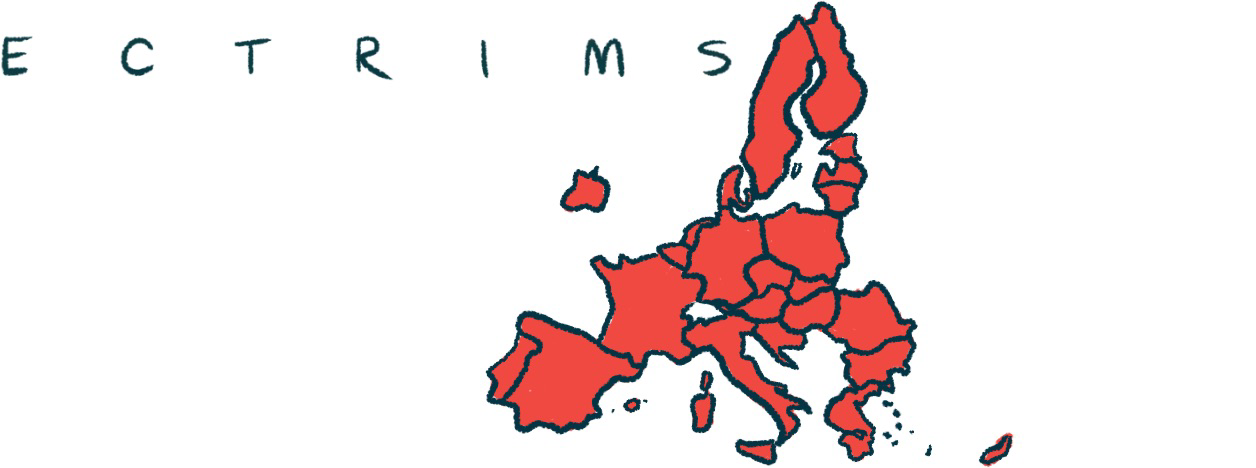ECTRIMS 2023: Under-the-skin Ocrevus found to be powerful in MS
New formulation seen to suppress MS activity in Phase 3 trial

A new under-the-skin formulation of Ocrevus (ocrelizumab) — administered in 10 minutes — is at least as effective as the approved intravenous, or into-the-vein, formulation among people with multiple sclerosis (MS), according to new clinical trial data.
Most people given either the new subcutaneous formulation or the intravenous one experienced drastic reductions in B-cells within a couple of weeks of receiving Ocrevus, and the majority had no relapses or new MRI activity over six months of treatment in the Phase 3 trial.
That’s according to new data shared at this year’s joint meeting of the European Committee for Treatment and Research in Multiple Sclerosis (ECTRIMS) and the Americas Committee for Treatment and Research in Multiple Sclerosis (ACTRIMS), taking place this week in Milan, Italy, and online.
The poster, “Subcutaneous Ocrelizumab in Patients With Multiple Sclerosis: Results of the Phase III OCARINA II Study,” was presented by Scott Newsome, a professor of neurology at the Johns Hopkins University, in Maryland. The work was funded by Roche, which markets Ocrevus through its subsidiary Genentech.
“We are pleased to share that Ocrevus 10-minute subcutaneous injection suppressed brain lesions as effectively as the intravenous infusion,” Levi Garraway, MD, PhD, Genentech’s chief medical officer and head of global product development, said in a company press release.
A 10 minute vs. 2 hour time for treatment to be given
Ocrevus is an antibody-based medication that works to deplete B-cells, a type of immune cell that plays a central role in the inflammatory attack that causes MS. The therapy is approved for patients with relapsing types of MS, and it’s also the only authorized treatment for the primary progressive form of the disease (PPMS).
The approved formulation of Ocrevus is administered every six months via an infusion into the bloodstream that takes about two hours.
Now, Roche is developing a novel formulation that’s given by a healthcare professional as a 10-minute subcutaneous injection — administered into the tissue layer between the skin and the muscle — every six months.
The company hopes that the new formulation may be more convenient and improve access to treatment for patients and clinicians for whom regular infusions aren’t feasible.
“Accessing IV [intravenous] administration can be challenging for some patients, especially if they don’t live close to an infusion center,” Ashish Pradhan, MD, executive director and disease area lead of neuroimmunology at Genentech, said in an email to Multiple Sclerosis News Today.
“Additionally, some MS treatment centers have limited … capacity [to administer intravenous treatments] or no access to IV infrastructure,” Pradhan said, adding, “We developed the Ocrevus subcutaneous injection to potentially expand access to even more patients who could benefit from the medicine.”
According to Garraway, the goal is to lessen the treatment burden on both sides.
“Having this additional treatment option may improve the treatment experience for both patients and physicians, and we hope the twice-a-year dosing will offer the same high adherence and persistence” as seen with the approved formulation, Garraway said.
We developed the Ocrevus subcutaneous injection to potentially expand access to even more patients who could benefit from the medicine.
Roche now is running an open label Phase 3 clinical trial called OCARINA II (NCT05232825) that’s testing the approved intravenous (IV) formulation of Ocrevus against the novel subcutaneous (SC) one. The trial involves 236 people with relapsing MS or PPMS.
As of the analysis presented at ECTRIMS, more than half of the study’s participants (53.4%) have been followed for at least six months.
The study’s main goal is to compare the pharmacological properties of the two formulations — specifically the amount of the therapy that’s active in the body over the first 12 weeks, or about three month, after dosing.
Safety, efficacy of both formulations seen to be comparable
Top-line results announced a few months ago showed that both formulations led to similar levels of the therapy in the body, with peak levels in the blood around 130-140 micrograms per milliliter in both groups.
Most patients — 97% given the SC formulation and 98% given the IV version — had B-cell counts lower than 5 cells per microliter of blood within two weeks after the first dose. Further, these low B-cell counts were maintained for most patients out to six months.
From available efficacy data out to six months, almost all patients (99%) were free of relapses. Two participants in the trial experienced an MS relapse: one was given the SC formulation, the other received the approved IV Ocrevus.
MRI data also showed a profound reduction in MS disease activity with both formulations of Ocrevus. At six months, the average number of actively inflamed or new/enlarging lesions was zero in both treatment groups.
The SC formulation of Ocrevus “resulted in near-complete suppression of radiological (MRI) and clinical (relapses) disease activity up to Week 24, similar to [IV Ocrevus],” the researchers concluded.
Safety data for both formulations were generally comparable, and about a third of patients given either formulation experienced infections.
“No new safety concerns were identified,” the scientists wrote.
The only notable difference was that nearly half (48.3%) of the individuals given the subcutaneous version experienced injection-related reactions, whereas infusion-related reactions were reported in fewer than 20% of those given the approved IV formulation. Specifically, 1 in 8 patients (16.9%) on the intravenous formulation had a reaction related to the infusion.
All of the injection-related reactions reported with the SC formulation were judged to be mild or moderate in severity and most resolved without treatment.
“We are excited by the data presented at the congress and hope that we may provide an alternative twice-a-year treatment option, in addition to IV, so that the administration of Ocrevus can be matched to the individual needs of patients and HCPs,” Pradhan said.
New formulation could reduce treatment burden for patients
The dosage of ocrelizumab used for the subcutaneous injection in the OCARINA II study was 920 mg per injection, compared with 600 mg used for the approved intravenous infusion.
This dose was selected based on data from a previous Phase 1 study called OCARINA I (NCT03972306). That trial had tested subcutaneous injections at doses ranging from 40 to 1,200 mg in 131 adults with MS. About two-thirds of the patients had previously been on Ocrevus, while the rest were new to the treatment.
The findings from OCARINA I were presented at the ECTRIMS conference in a separate poster, titled “Subcutaneous Ocrelizumab in Patients With Multiple Sclerosis: Results of the Phase Ib Dose-Finding OCARINA I Study.”
Pharmacological data from the study suggested that a dose of 900 mg would provide a similar level of the drug to the approved IV formulation. The actual dose was then adjusted to 920 mg because, based on the concentration of the therapy in solution, this amount requires a volume of exactly 23 milliliters. That volume is easier to precisely draw up in a syringe as it’s a whole number, the researchers noted.
Overall, the safety data from the Phase 1 study did not reveal any unexpected findings. Patient-reported data suggested that the SC formulation was well received: 93.9% of patients said they were either satisfied or very satisfied with the SC procedure, and 87.8% rated the SC injection as convenient or very convenient.
“Most patients who received [subcutaneous ocrelizumab at doses of] 1,200 mg or 920 mg reported being satisfied with the SC treatment administration,” the researchers concluded.
This new formulation “could deliver clinical benefit, significantly reduced time and treatment burden, improved resource use,” the team wrote, adding that it also offered greater flexibility in administration and the site of patient care.
Roche previously announced that it will be seeking regulatory approvals for this subcutaneous formulation based on the positive data from these trials.
Note: The Multiple Sclerosis News Today team is providing in-depth coverage of the 9th joint ECTRIMS-ACTRIMS meeting Oct. 11-13. Go here to see the latest stories from the conference.









